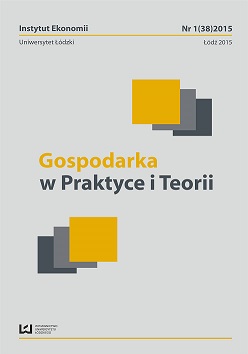Sustainable shaping of anthropopressure
DOI:
https://doi.org/10.18778/1429-3730.38.02Keywords:
the foundations of civilization, sustainable development, antropopressureAbstract
Developed democratic countries seek to ensure that development is not accidental and meets certain established goals and limitations. These arise from the nature of sustainable development, which has now become a fundamental category for civilization. The development process is driven and conditioned by a set of rules that must be complied with by any developing entity. These principles derive from the inherent characteristics and qualities of sustainable activities (support, maintenance, and existence) which provide for a long, multi-generational existence. They also form the three pillars derived directly from the canons of culture: values and ethics, laws of nature and physics, and economic efficiency and performance management. The work presents a set of directives and instruments which form the conceptual framework of an entity’s sustainable development activities, the object of which is: good human health; a durable and high quality of life; economic growth and innovation, and efficiency in the economic sector; the permanent provision of an adequate level of consumption for each member of the global community; as well as increasing the quantity and improving the quality of environmental resources and the multiplication of cultural goods.
References
Bjørn A., Hauschild M. Z. (2013), Absolute versus Relative Environmental Sustainability, Journal of Industrial Ecology, 17(2), 321–332.
Google Scholar
DOI: https://doi.org/10.1111/j.1530-9290.2012.00520.x
Buckeridge J. (2014), Environmental ethics: an overview, assessing the place of bioscientists in society, supplemented with selected Australian perspectives. Integrative Zoology, 9(1), 14–23.
Google Scholar
DOI: https://doi.org/10.1111/1749-4877.12028
Carter N. H., Shrestha B. K., Karki J. B., Pradhan N., Jianguo L. (2012), Coexistence between wildlife and humans at fine spatial scales. Proceedings of The National Academy of Sciences of The United States of America, 109(38), 15360–15365.
Google Scholar
DOI: https://doi.org/10.1073/pnas.1210490109
Chin A., Florsheim J., Wohl E., Collins B. (2014). Feedbacks in Human-Landscape Systems, Environmental Management, 53(1), 28–41. doi:10.1007/s00267-013-0031-y
Google Scholar
DOI: https://doi.org/10.1007/s00267-013-0031-y
Janikowski R. (2006), Zrównoważony rozwój lokalny. Teoria i praktyka, Polska Akademia Nauk, Komitet „Człowiek i Środowisko” przy Prezydium PAN, Górnośląska Wyższa Szkoła Handlowa, Studia nad Zrównoważonym Rozwojem, Tom IV, Warszawa–Katowice.
Google Scholar
Janikowski R. (2007), Ekoinowacyjność – wyzwaniem dla europejskiego przedsiębiorcy, [w:] K. Jędralska (red.) Współczesne kierunki rozwoju nauk o zarządzaniu, Górnośląska Wyższa Szkoła Handlowa, Katowice.
Google Scholar
Janikowski R. (2007), Sustensologia a zrównoważony rozwój, [w:] B. Poskrobko, G. Dobrzański (red.) Problemy interpretacji i realizacji zrównoważonego rozwoju, Wydawnictwo Wyższej Szkoły Ekonomicznej, Białystok.
Google Scholar
Janikowski R. (2009), Kultura osią zrównoważonego rozwoju, [w:] R. Janikowski, K. Krzysztofek, (red.), Kultura a zrównoważony rozwój. Środowisko, ład przestrzenny, dziedzictwo, Polski Komitet do spraw UNESCO, Warszawa.
Google Scholar
Janikowski R. (2010), Wymiary zrównoważonego rozwoju. Rozwój lokalny, gospodarka przestrzenna, zdrowie środowiskowe, innowacyjność, Wydawnictwo Wyższej Szkoły Bankowej w Poznaniu, Wrocław–Poznań.
Google Scholar
Janikowski R. (2011), Die Bedeutung des Kulturkapitals für nachhaltige Entwicklung, [w:] G. Banse, R. Janikowski, A. Kiepas (red.), Nachhaltige Entwicklung – transnational. Sichten und Erfahrungen aus Mitteleuropa, Edition Sigma, Berlin.
Google Scholar
DOI: https://doi.org/10.5771/9783845267722-33
Janikowski R., Krzysztofek K. (red.) (2009), Kultura a zrównoważony rozwój. Środowisko, ład przestrzenny, dziedzictwo, Polski Komitet do spraw UNESCO, Warszawa.
Google Scholar
Knights, A. M., Koss, R. S., Robinson, L. A. (2013). Identifying common pressure pathways from a complex network of human activities to support ecosystem-based management. Ecological Applications, 23(4), 755–765.
Google Scholar
DOI: https://doi.org/10.1890/12-1137.1
Kostecka J. (2010), Retardacja materialnego przekształcania zasobów przyrodniczych jako element zrównoważonego rozwoju, Biuletyn KPZK PAN, Zeszyt 242, 27–49.
Google Scholar
Kostecka J. (red.) (2010), Retardacja materialnego przekształcania zasobów przyrodniczych, Biuletyn KPZK PAN, Zeszyt 242, Warszawa.
Google Scholar
Kronenberg J., Bergier, T. (red.) (2010), Wyzwania zrównoważonego rozwoju w Polsce, Fundacja Sendzimira, Kraków.
Google Scholar
Menzel S., Green T. L. (2013), Sovereign Citizens and Constrained Consumers: Why Sustainability Requires Limits on Choice. Environmental Values, 22(1), 59–79.
Google Scholar
DOI: https://doi.org/10.3197/096327113X13528328798273
Michalski K. (2007), Interdyscyplinarność – transdyscyplinarność – multidyscyplinarność nowy paradygmat w nauce i badaniach, Zeszyty Naukowe Politechniki Rzeszowskiej. Ekonomia i Nauki Humanistyczne, t. 235, z.16, s. 83–100.
Google Scholar
Pettit C., Chung W., Sharifi V., Chalabi Z., Fletcher T., Cleall P., Azapagic A. (2011), Sustainable management of urban pollution: an integrated approach. Building Services Engineering Research & Technology, 32(1), 21–34.
Google Scholar
DOI: https://doi.org/10.1177/0143624410394528
Pleil J. D. (2012), Categorizing Biomarkers of the Human Exposome and Developing Metrics for Assessing Environmental Sustainability. Journal of Toxicology & Environmental Health: Part B, 15(4), 264–280.
Google Scholar
DOI: https://doi.org/10.1080/10937404.2012.672148
Schmidt J. H. (2008), Development of LCIA characterisation factors for land use impacts on biodiversity. Journal of Cleaner Production, 16(18), 1929–1942.
Google Scholar
DOI: https://doi.org/10.1016/j.jclepro.2008.01.004
Siikamäki J., Wernstedt K. (2008), Turning Brownfields into Greenspaces: Examining Incentives and Barriers to Revitalization, Journal Of Health Politics, Policy & Law, 33(3), 559–593.
Google Scholar
DOI: https://doi.org/10.1215/03616878-2008-008
Simion I., Ghinea C., Maxineasa S., Taranu N., Bonoli A., Gavrilescu M. (2013), Ecological Footprint Applied in the Assessment of Construction and Demolition Waste Integrated Management, Environmental Engineering & Management Journal (EEMJ), 12(4), 779–788.
Google Scholar
DOI: https://doi.org/10.30638/eemj.2013.097
Tukker A., Jansen B. (2006), Environmental impacts of products: A detailed review of studies, Journal of Industrial Ecology, 10(3) 159–182.
Google Scholar
DOI: https://doi.org/10.1162/jiec.2006.10.3.159
WCED (1987) Our Common Future. World Commission on Environment and Development, Oxford, University Press, Oxford.
Google Scholar








